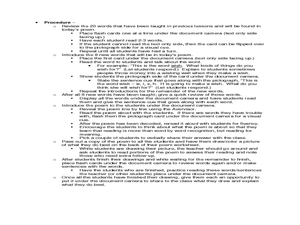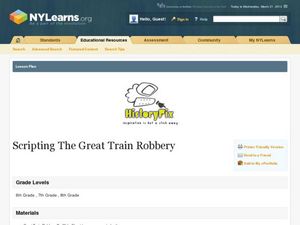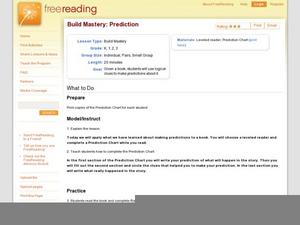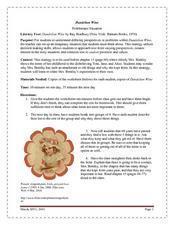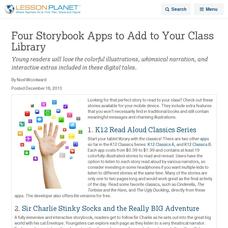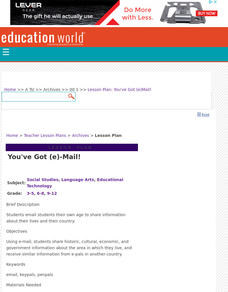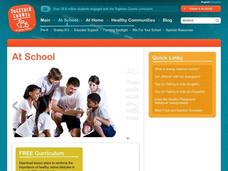Curated OER
Learning Sight Words with Picture Me Reading and the Document Camera
First graders identify sight words. In this learning sight words lesson, 1st graders view flash cards to practice the words and identify them in a poem.
Curated OER
Analyzing a Picture
Learners examine various photographs and identify three conclusions from them. Using the pictures, they write their own story based on their observations. They share their stories with the class and discuss how some of their...
Facing History and Ourselves
Finding Your Voice
To begin a study of what it means to be American, high schoolers first consider their own identities. They draw a picture of what they think an American looks like and share their images. Next, they examine an image of the "Flag of...
Facing History and Ourselves
Identity and Choices
Timshel! Thou mayest! is the big idea in a instructional activity that reminds learners that they have choices about how they present themselves to others. To begin, individuals rate the degree to which the choices they make each morning...
Alabama Learning Exchange
Yummy Apples!
Young learners listen to a read aloud of Gail Gibbons book, Apples and the story A Red House With No Windows and No Doors. They compare characteristics of a number of kinds of apples, graph them and create a apple print picture. Learners...
Curated OER
Self-Monitoring Strategies and Vocabulary Games
Middle and high schoolers identify how to discover a word's meaning by exploring context clues and any pictures, diagrams, photographs, and charts that might be included. They continue this process with other examples and locate one on...
BBC
Ourselves
Young biologists identify parts of the body, sort humans from other animals, and list the difference they see. Learners are split up into groups of three, and each group must find pictures in magazines of humans and other animals. They...
Curated OER
Scripting The Great Train Robbery
Take writing prompts to another level in this activity, which allows pupils to create scenes of dialogue based on the 1903 silent film, The Great Train Robbery. Useful for a language arts/history cross-curricular activity, the lesson...
Curated OER
Build Mastery: Prediction
What do you think will happen? Use a graphic organizer to help learners predict what will happen in a text. Consider modeling the chart using a familiar story, pretending you don't know what happens. Show scholars the book, explaining...
Curated OER
Dandelion Wine: Problematic Situation
If forced to move and give away almost everything you own, what five non-essential things would you take with you? Prior to reading about Mrs. Bentley in chapter 15 of Dandelion Wine, individuals are asked to respond to this...
EngageNY
Launching the Text: Building Background Knowledge on Louie Zamperini and World War II (Preface, Pages 3–6)
Scholars participate in a gallery walk to examine photographs related to WWII and record thoughts about the pictures in note catchers. At the end of the gallery walk, pupils share their observations before participating in a discussion...
Curated OER
Four Storybook Apps to Add to Your Class Library
Young readers will love the colorful illustrations, whimsical narration, and interactive extras included in these digital tales.
Alabama Wildlife Federation
Leaf Chromatography
Pigmentation of leaves is important in plant processes. Scholars use chromatography to create a better picture of the pigmentation in an assortment of leaves. They share their results to make comparisons between different plant species.
Teaching Tolerance
Using Photographs to Teach Social Justice | Supporting Social Border Crossings
A lunch-time activity encourages pupils to step out of their usual lunch bunch and connect with someone new. To begin, individuals examine a group photograph and identify what they believe is the gender, race, religion, and sexual...
Curated OER
Shapes Around Us
Pupils identify basic two-dimensional shapes. They are able to identify the four basic two-dimensional shapes: squares, rectangles, triangles, and circles. Students write/draw in their learning logs a reflection of what they noticed...
Curated OER
You've Got Email!
Students email students their own age in another country to share information about their cultures and countries.
Curated OER
Real-Life Problems
Introduce scholars to addition and subtraction word problems with visual guidance. There are five scenarios here, each with a picture to guide scholars as they solve. An example encourages kids to physically interact with the images,...
Curated OER
The Big Sneeze
Students participate in a variety of shared reading and writing activities related to the book "The Big Sneeze" by Ruth Brown. They develop a list of farm vocabulary, sequence the events of the story on a graphic organizer, act out...
Curated OER
To Be Black and American: The Great Depression
Twelfth graders view pictures and write a description of what is depicted in the picture. They then divide into groups of three to share what they have written and come to a consensus of what the picture represents.
Curated OER
The Island of the Skog
"Students read "The Island of the Skog." Prior to reading, students observe the book cover, predict the events of the story, and discuss what a skog may look like. Students make footprints in play dough and observe the differences...
Curated OER
Using Imagery
Show, don't tell! Pairs work together to change a list of telling sentences into showing sentences using picture words that create vivid pictures in the readers’ minds.
Curated OER
Investigation - Mathematical Reasoning: Tables and Chairs
Fourth graders draw pictures and diagrams as they attempt to solve a mathematical problem involving the arrangement of eleven tables shaped like equilateral triangles and the seating of exactly twenty-five people.
Curated OER
The Changing Times of The Future
First graders share their wishes for the future and discuss changes that have taken place. They observe a puppet who describes life in the future and identifies positive and difficult challenges he may face. Individual students draw a...
Curated OER
How Balanced Are You?
Help young learners look at energy in and energy out. Discuss how different activities may require different amounts of energy in. Use the included worksheet to have them write or draw pictures of what they ate in one day and what...
